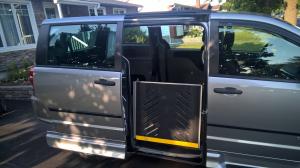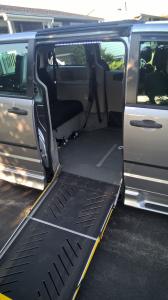JPN Taxi
JPN Taxi
In anticipation of more wheelchair users visiting Japan for the Olympics/Paralympics in 2020, there is a new taxi vehicle called JPN Taxi introduced last year that not only is for regular taxi users, but can also accommodate wheelchair users if the rear seat is folded up and a manual ramp is deployed. You can see many of these types of taxis with high roofs and low floors driving around Japan’s cities these days. Conceptually, it is a good example of barrier free design in the sense that wheelchair users don’t need to hire a special taxi with a wheelchair lift, but I have heard that some bigger-sized electric wheelchairs can not fit, so it is not a perfect solution. As well, currently wheelchair uses only account for one in several thousand taxi passengers in Japan, so the taxi drivers are not very well practiced in deploying the ramp and securing the passenger so it takes up to 10 minutes or more. Just so you know, wheelchair passengers get charged the same taxi fare as regular passengers (the time it takes for the passenger to board/de-board is not charged to the passenger), but unfortunately, some wheelchair users I know have opted for transferring to the regular taxi seat and putting their folding wheelchair in the trunk because putting the ramp out was too cumbersome. Simply said, the ramp and securing the wheelchair were not designed with efficiency in mind.
Full disclosure, I work in the transportation industry in Japan. One of my colleagues at work is in charge of reducing the time it takes for wheelchair users to board the JPN Taxi by making the ramp easier for the driver to deploy and simpler to secure the passenger. We got into a discussion about what length of time the customer would be satisfied with. If anyone has any input, please let me know or select from the following choices.
Question. How much time do you think is practical from the wheelchair user’s point of view to board a taxi with a manually deployed ramp?
a)The amount of time doesn’t matter.
b)Greater than 5 minutes, but less than 10, minutes is ok
c)Less than 5 minutes is desired
d)Less than 3 minutes is desired
Log in to reply.


